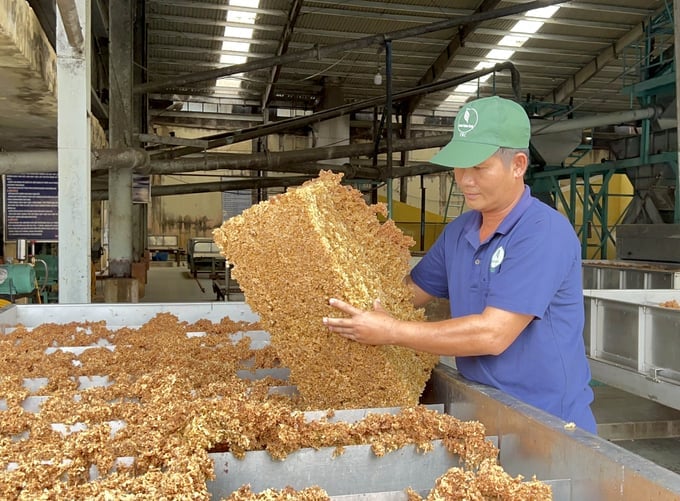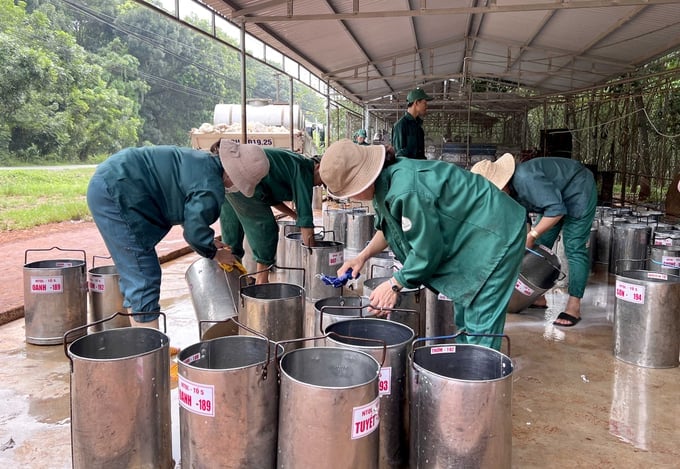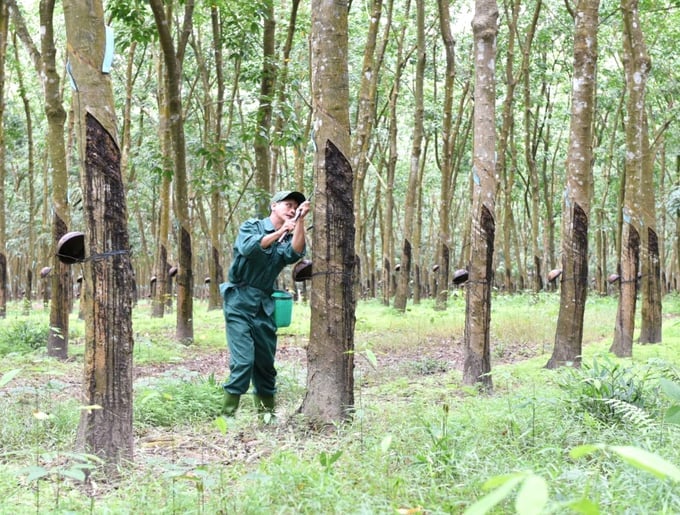November 27, 2025 | 10:03 GMT +7
November 27, 2025 | 10:03 GMT +7
Hotline: 0913.378.918
November 27, 2025 | 10:03 GMT +7
Hotline: 0913.378.918

Processing rubber latex at Tay Ninh Rubber Joint Stock Company. Photo: Tran Phi.
Reuse discharged water and waste
Hiep Thanh Rubber Processing Factory (Go Dau district, Tay Ninh) is one of two factories of Tay Ninh Rubber Joint Stock Company (Taniruco), with a total capacity of 9,900 tons/year. In 2022, on average each day, the plant had a total wastewater flow of about 373.44 m3 (7.14 m3 of utility wastewater and 366.3 m3 of production wastewater). All wastewater has been treated to meet column A standards (able to be poured into water bodies that are usually used as utility water sources) through a wastewater treatment system with a total capacity of 1,700 m3/day.
It is worth noting that more than half of the daily wastewater volume at Hiep Thanh Rubber Processing Factory, after being processed according to standards, is collected into the oxidation ditch. After that the water is then pumped through plastic pipes to supply for the washing process of waste latex rubber materials in the SVR 10 and SVR 20 rubber production lines. The reuse of treated wastewater is applied to the entire SVR 10 and SVR 20 rubber production line with mixed latex materials. The segment lasted from the beginning of the season until the end of the production season without limiting the seasonal limitation. This shows that Taniruco is doing quite well in reusing wastewater, thereby helping to save significant costs and contributing to more effective use of water resources.
In addition to promoting wastewater reuse at rubber latex processing factories, many other types of waste are also being recycled by Taniruco for effective use to reduce waste. For example, sludge from the wastewater treatment system was collected and temporarily stored in the sludge pressing area, then transported to the company's farms to fertilize rubber trees.
Mr. Nguyen Hong Thai, Deputy General Director of Taniruco, shared, that one of the typical initiatives related to environmental and social responsibility, the green development strategy that the company has implemented is the reuse of plastic materials (bottles). The company use recycled materials to make pots for ornamental plants, beautify the workplace landscape, and raise awareness of waste management and recycling, contributing to the company's green development and sustainability strategy.
Currently, the entire Vietnam Rubber Group (VRG) has 41 wastewater treatment systems reaching column A standards. Many VRG member companies are promoting the reuse of this wastewater source in production activities at factories. At Binh Long Rubber Company Limited (Binh Phuoc), almost the entire amount of treated wastewater has been reused to wash latex pus. At Dau Tieng Rubber Company Limited (Binh Duong), in 2022, over 30% of wastewater was reused after treatment to meet column A standards.
In addition to reusing wastewater in factories, the treatment and reuse of wastewater at rubber latex delivery stations is also being implemented by many companies. Accordingly, the entire amount of water used to rinse tools and latex-receiving floors,... is collected in the pus decanting pit. After removing all remaining latex, the water will be preliminarily treated to irrigate the rubber garden.

Binh Long Rubber workers rinse tools at the latex delivery station. All rinsed water is pre-treated and irrigated for the rubber garden. Photo: Thanh Son.
Production in a greener and cleaner manners
In addition to reusing water, plastic waste,..., to produce in greener and cleaner manners, many important solutions are being applied by Taniruco at rubber processing factories. For example, in Hiep Thanh Rubber Processing Factory, many trees have been planted in factory areas, on internal roads and in raw material receiving yards. The factory aims to regulate microclimate and control dust while reducing the level of odour dispersion into the surrounding environment.
To minimize NH3 gas generated from the latex and skim latex production factory, Taniruco has installed an NH3 gas recovery system at the latex centrifugation stage. Thanks to this solution, the remaining NH3 gas in the skim latex is negligible (NH3 concentration is about 0.35%). To eliminate NH3 gas, the company pumped skim latex solution into the reduction tower. Taniruco has also installed a system to treat odours and emissions generated during the drying process. Accordingly, all emissions generated from this stage have been fully collected by Taniruco.
Improving rubber latex processing technology in factories also makes an important contribution to cleaner production, thereby contributing to environmental protection and moving towards green production in the rubber industry.
Mr. Do Minh Tuan, General Director of Dong Nai Rubber Corporation (Donaruco), said, that Donaruco has changed the SVR10 latex processing technology from the previous continuous processing method to the latex rolling method before the processing. The improvement of the process has helped the quality of processed latex to be stable and meet many standards. The PRI and Po criteria have been improved (due to the raw materials after incubation are uniform and stable in quality).
In particular, the latex is rolled and squeezed immediately so the amount of water and fat is removed, thereby minimizing odours at the factory. In addition, improving the process helps to reduce the amount of pollutants released into the environment during the drying process. The exhaust gas treatment process is easier and causes less environmental pollution. Fuel consumption also decreased significantly, from 24kg of gas/ton of product with the old technology to 21kg of gas/ton of product with the new technology.

VRG promotes the development of green agriculture and green industry. Photo: Tran Phi.
In the rubber industry's green growth strategy, greening the production process is an important goal. Accordingly, VRG builds a strategy of "clean industrialization" by reviewing and adjusting the main business sector and business plans, using resources economically and effectively. At the same time, promotes the development of green agriculture and green industry with a structure of human resources, technology and equipment that ensures environmentally friendly principles.
Translated by Hoang Duy
/2025/11/26/4909-2-154329_878.jpg)
(VAN) Pearl grouper farming in HDPE cages not only delivers economic efficiency but also contributes to protecting the environment, creating jobs, and promoting marine-based experiential tourism.

(VAN) The model of making a living under the forest canopy through the agroforestry system in Van Son commune, Bac Ninh province, is expected to generate an annual income of approximately VND 30 million/ha.

(VAN) Many enterprises in Can Tho are harnessing natural energy and reducing greenhouse gas emissions in their production processes, thereby contributing to the promotion of a sustainable green transition.
/2025/11/24/3536-2-112800_176.jpg)
(VAN) Dong Nai now has tens of thousands of hectares of forests certified for sustainable management, and this area will continue to be expanded in the coming period.

(VAN) Vinh Ha hamlet (Dai Xuyen commune, Hanoi) is shifting away from small-scale farming as households adopt bioscurity into their breeder chicken models.

(VAN) Heavy rains make aquatic species more vulnerable to disease. Proactive water management and high-tech systems help farmers prevent outbreaks and protect yields.

(VAN) Greenhouses are shifting production mindsets in Binh Lu commune, enabling farmers to ‘weather the sun and rain’ and secure stable vegetable harvests throughout the year.